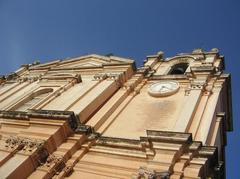
Guide to Visiting Triq ta’ Vnezja in Mdina, Malta
Date: 18/07/2024
Introduction
Table of Contents
- Introduction
- Background and Historical Significance
- Triq ta’ Vnezja: A Window to the Past
- Visitor Information
- Nearby Attractions and Accessibility
- A Place of Tranquility and Reflection
- Unique Aspects and Special Events
- Conclusion
- FAQ
Background and Historical Significance
Mdina: The Heart of Malta’s History
To understand Triq ta’ Vnezja, one must first delve into the rich tapestry of Mdina itself. Founded by the Phoenicians around the 8th century BC, Mdina boasts over 4,000 years of history. The Phoenicians, known for their maritime prowess, named the city ‘Maleth,’ meaning ‘safe haven.’ This name was apt, as Mdina’s naturally fortified hilltop location provided a strategic advantage against invaders.
Roman Rule and the Arrival of Christianity
The Romans, who succeeded the Phoenicians, further developed Mdina, adorning it with opulent villas and public buildings. It was during Roman rule, around 60 AD, that the apostle St. Paul is said to have been shipwrecked on Malta, bringing Christianity to the island. Legend has it that St. Paul resided within Mdina’s walls, solidifying the city’s religious significance.
Arab Influence and the Rise of a Medieval City
The Arabs conquered Malta in the 9th century, leaving an indelible mark on the island’s language, culture, and architecture. They fortified Mdina, adding to its defensive capabilities and giving it the Arabic name ‘Medina,’ meaning ‘walled city.’ The city flourished under Arab rule, becoming a center of trade and scholarship.
The Knights of St. John and the Renaissance
In 1530, the Knights of St. John, a Catholic military order, were granted sovereignty over Malta by Charles V of Spain. The Knights, renowned for their chivalry and military prowess, made Mdina their noble seat. During their reign, Mdina underwent a Renaissance transformation, with the construction of elegant palaces, churches, and fortifications.
Triq ta’ Vnezja: A Window to the Past
Triq ta’ Vnezja, nestled within Mdina’s walls, reflects this rich historical tapestry. While its exact origins are debated, the street likely dates back to the medieval period, serving as a vital passage within the city’s fortifications. Its name, Triq ta’ Vnezja, hints at a connection with Venice, possibly reflecting trade links or the presence of Venetian merchants during the city’s prosperous eras.
A Strategic Vantage Point
The street’s position atop Mdina’s bastions underscores its strategic importance. From here, guards could monitor the surrounding countryside, watching for potential threats. Today, visitors can stand on Triq ta’ Vnezja and enjoy the same breathtaking panoramas that captivated those who came before them.
A Testament to Mdina’s Evolution
Triq ta’ Vnezja’s architecture reflects Mdina’s evolution through the ages. The street features a mix of architectural styles, from medieval stonework to Baroque flourishes, each telling a story of the city’s past. The honey-colored limestone buildings, adorned with colorful doors and window boxes overflowing with flowers, create a charming and timeless ambiance.
Visitor Information
Visiting Hours and Tickets
Triq ta’ Vnezja is accessible at all times as it is a public street. No tickets are required to explore this historic lane.
Travel Tips
- Wear comfortable shoes: The flagstone paths can be uneven.
- Best times to visit: Early mornings or late afternoons to avoid the midday heat and crowds.
Nearby Attractions and Accessibility
St. Paul’s Cathedral
Located nearby, this 17th-century Baroque cathedral is a must-visit for its stunning architecture and historical significance.
Mdina Dungeons
Experience a chilling journey through Malta’s darker history with a visit to the Mdina Dungeons, located just a short walk from Triq ta’ Vnezja.
Accessibility
Mdina is a pedestrianized city, which means no vehicles are allowed within its walls. This makes it easy to explore on foot, but those with mobility issues should be aware that the streets are often narrow and uneven.
A Place of Tranquility and Reflection
Today, Triq ta’ Vnezja is a tranquil oasis within the bustling island of Malta. The street’s pedestrianized nature allows visitors to stroll leisurely, soaking in the history and beauty of their surroundings. The panoramic views, stretching across the island’s verdant landscape, offer a moment of peace and reflection.
Unique Aspects and Special Events
Photographic Spots
The street offers numerous picturesque spots perfect for photography, especially during golden hour.
Guided Tours
Several guided tours of Mdina include Triq ta’ Vnezja, providing deeper insights into its historical significance and hidden gems.
Conclusion
Triq ta’ Vnezja is an essential stop on any visit to Mdina. Its historical significance, architectural charm, and breathtaking views make it a truly unforgettable experience. As you wander along its flagstone path, let the whispers of history transport you back in time, imagining the knights, nobles, and ordinary citizens who once walked this very street.
FAQ
1. What are the visiting hours for Triq ta’ Vnezja? Triq ta’ Vnezja is accessible at all times as it is a public street.
2. Do I need tickets to visit Triq ta’ Vnezja? No, there are no tickets required to explore this historic lane.
3. What are some nearby attractions to Triq ta’ Vnezja? Nearby attractions include St. Paul’s Cathedral and the Mdina Dungeons.
4. Are there guided tours available? Yes, several guided tours include Triq ta’ Vnezja, providing deeper insights into its historical significance.
5. Is Triq ta’ Vnezja accessible for those with mobility issues? Mdina is pedestrianized, making it easy to explore on foot, but the streets are often narrow and uneven, which might be challenging for those with mobility issues.
Call to Action
For more historical insights and travel tips, follow us on social media and check out our related posts on Mdina’s historical sites. Download our mobile app for an interactive guide to Malta’s treasured locations!

